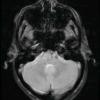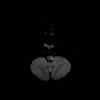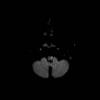return to: Unilateral Laryngeal Paralysis or Vocal Cord Paralysis
see: Tapia Syndrome paralysis of vagus and hypoglossal nerves after intubation
Wallenberg syndrome = Lateral medullary syndrome (aka 'PICA' syndrome Posterior Inferior Cerebellar Artery syndrome)
-
Constellation of neurologic symptoms due to injury to the lateral part of the medulla in the brain
-
Sensory deficits affecting the trunk (torso) and extremities on the opposite side of the infarction
-
loss of pain and temperature sensation on the contralateral (opposite) side of the body
-
-
Sensory deficits affecting the face and cranial nerves on the same side with the infarct.
-
loss of pain and temperature sensation on the ipsilateral (same) side of the face.
-
-
-
Clinical symptoms include difficulty swallowing, slurred speech, facial pain, vertigo, Horner syndrome, and possibly palatal myoclonus
-
Otolaryngological features include dysphonia, dysphagia and nasal regurgitation related to:
-
ipsilateral vocal fold paralysis
-
palatal and pharyngeal paresis
-
may also be associated with obstructive sleep apnea and airway obstruction (Vaidyanathan 2007)
4. A complete Wallenberg syndrome is not common with key factors in clinical diagnosis being 'crossed hemiparesis or hemianesthesia' indicating a brainstem lesion
5. Estimated 60,000 new cases in the United States each year with usually a better outcome - with most common sequelae being gait instability and most patients returning to satisfactory activities of daily living (Lui 2019).
Etiology
-
Most commonly caused by atherothrombotic occlusion of the vertebral artery (then posterior inferior cerebellar arteray and least often the medullary arteries.
-
Risk factors
-
Hypertension is most common risk factor with other causes
-
Vertebral artery dissection associated with:
-
History of trauma, neck
-
Underlying collagen vascular disease
-
-
Anatomy
-
involvement of nucleus ambiguus: dysphagia, dysphonia and dysarthria
-
laryngeal, pharyngeal and palatal paralysis
-
involvement of trigeminal nucleus: ipsilateral facial and corneal anesthesia
-
involvement of spinothalamic tract: loss of pain and temperature sensation to the opposite side of body
-
involvement of cerebellum: ataxia
-
involvement of hypthalamic fibers: sympathetic nervous system abnormal c/w Horners syndrome
-
involvement of Deiters' nucleus and other vestibular nuclei: nystagmus and vertigo
-
involvement of central tegmental tract: palatal myoclonus
-
Radiology (MRI)
Trigeminal Trophic Syndrome:
A. May be associated with Wallenberg's syndrome and is a rare cause of facial ulcerations associated with injury to the trigeminal nerve (Parimalam 2014) with the syndrome comprised of triad of:
1. Anesthesia
2. Paresthesia
3. Secondary persistent or recurrent facial ulceration
B. First described by Wallenberg in 1901 (cutaneous ulceration in the trigeminal dermatome)
References
Parimalam Kumar, Jayakar Thomas Trigeminal Trophic Syndrome Indian J Dermatol. 2014 Jan-Feb; 59(1): 75–76. doi: 10.4103/0019-5154.123506
Rashid RM, Khachemoune A. Trigeminal trophic syndrome. J Eur Acad Dermatol Venereol. 2007 Jul;21(6):725-31. doi: 10.1111/j.1468-3083.2007.02250.x. PMID: 17567297.
Loveman AB. An unusual dermatosis following section of the fifth cranial nerve. Arch Dermatol Syph. 1933;28:369–75
Vaidyanathan S1, Capper R, Chadha D. Stridor: an unusual presentation of lateral medullary syndrome.J Laryngol Otol. 2007 Jul;121(7):e9. Epub 2007 Mar 19.
Lui F, Anilkumar AC. Wallenberg Syndrome. [Updated 2019 Jan 11]. In: StatPearls [Internet]. Treasure Island (FL): StatPearls Publishing; 2019 Jan-.Available from: https://www-ncbi-nlm-nih-gov.proxy.lib.uiowa.edu/books/NBK470174/
Ruedrich ED, Chikkannaiah M, Kumar G.Wallenberg's lateral medullary syndrome in an adolescent.Am J Emerg Med. 2016 Nov;34(11):2254.e1-2254.e2. doi: 10.1016/j.ajem.2016.05.022. Epub 2016 May 12.


